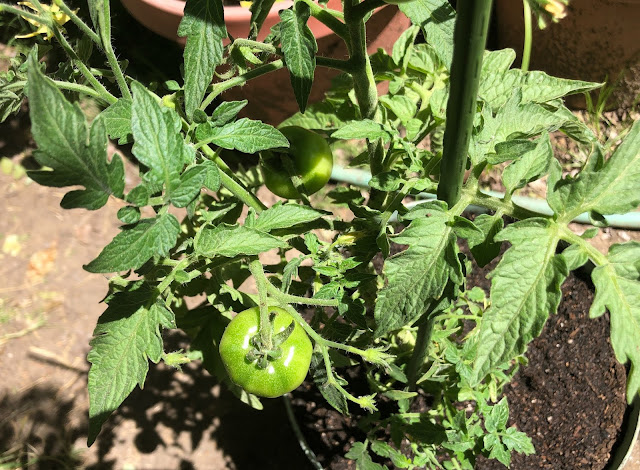
Surviving triple-digit temps comes down to moisture and mulch
 |
|
Container tomatoes, like this Orange Pixie, should be watered frequently during high temperatures. The soil can dry out much quicker than for in-ground tomatoes. (Photo: Kathy Morrison)
|
Tomatoes love heat and sun, but how much is too much?
Prolonged triple-digit heat waves can toast tomatoes and other sun-loving crops. Tomatoes in particular tend to be temperature sensitive.
When temperatures stay above 95 degrees, tomato flowers may drop off or refuse to set fruit. Leaves can fry and turn crispy. Ripening tomatoes may split or develop calluses.
Give your vines a hand – along with enough water and shade – to cope with this week’s heat. This advice comes from UC Cooperative Extension master gardeners as well as longtime local tomato growers.
* Water early and deep. Irrigate your tomatoes in the morning, making sure water reaches down at least 6 inches into the soil. How do you know? Test the soil with a probe or long screwdriver; it should easily plunge into the soil. Or use a trowel, dig down and look.
* During hot weather, water tomatoes two to three times a week. Tomatoes normally wilt during a hot afternoon; that’s OK. But if they’re wilted in the morning, water immediately. (Note: A few heirloom varieties, particularly of Russian origin, have a natural tendency to wilt all the time. But if you are growing one of these, you've probably noticed this already.)
* Tomatoes planted in containers may need extra water every day during hot weather. Their potting soil tends to dry out faster.
* Keep watering consistent and don’t let soil dry out completely. That can lead to blossom end rot, the hard brown callus on the flower end of a tomato.
* Mulch is your friend. Make sure your vines have at least 2 to 4 inches around them to help keep roots cool and soil evenly moist. Straw, leaves or shredded bark make the best tomato mulch. Many gardeners prefer straw (not hay) because its light color reflects intense sun rays instead of absorbing that added heat. (Also, hay contains seeds that can sprout and suck nutrients out of soil.)
* Don’t fertilize during a hot spell. Feeding now just puts more stress on the plant.
* Tomatoes love sun, but they can get sunburned. If leaves or developing fruit look bleached out or burned, give your vine some afternoon shade. Erect a temporary shade structure by draping burlap or shade cloth over the tomato cage or trellis. This also helps prevent fruit from cracking.
* If foliage turns brown, leave the dead leaves in place for now. They help protect the fruit from sunburn. After the heat has subsided, prune off the completely dead leaves so new foliage can grow.
Comments
0 comments have been posted.Sacramento Digs Gardening to your inbox.
Sites We Like
Garden Checklist for week of April 21
This week there’s plenty to keep gardeners busy. With no rain in the immediate forecast, remember to irrigate any new transplants.
* Weed, weed, weed! Get them before they flower and go to seed.
* April is the last chance to plant citrus trees such as dwarf orange, lemon and kumquat. These trees also look good in landscaping and provide fresh fruit in winter.
* Smell orange blossoms? Feed citrus trees with a low dose of balanced fertilizer (such as 10-10-10) during bloom to help set fruit. Keep an eye out for ants.
* Apply slow-release fertilizer to the lawn.
* Thoroughly clean debris from the bottom of outdoor ponds or fountains.
* Spring brings a flush of rapid growth, and that means your garden is really hungry. Feed shrubs and trees with a slow-release fertilizer. Or mulch with a 1-inch layer of compost.
* Azaleas and camellias looking a little yellow? If leaves are turning yellow between the veins, give them a boost with chelated iron.
* Trim dead flowers but not leaves from spring-flowering bulbs such as daffodils and tulips. Those leaves gather energy to create next year's flowers. Also, give the bulbs a fertilizer boost after bloom.
* Pinch chrysanthemums back to 12 inches for fall flowers. Cut old stems to the ground.
* Mulch around plants to conserve moisture and control weeds.
* From seed, plant beans, beets, cantaloupes, carrots, corn, cucumbers, melons, radishes and squash.
* Plant onion sets.
* In the flower garden, plant seeds for asters, cosmos, celosia, marigolds, salvia, sunflowers and zinnias.
* Transplant petunias, zinnias, geraniums and other summer bloomers.
* Plant perennials and dahlia tubers for summer bloom.
* Mid to late April is about the last chance to plant summer bulbs, such as gladiolus and tuberous begonias.
* Transplant lettuce seedlings. Choose varieties that mature quickly such as loose leaf.